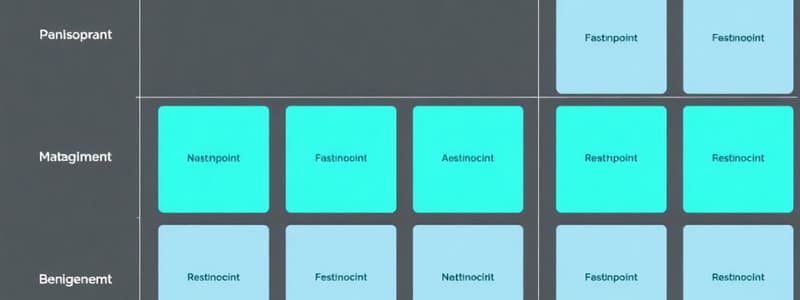Podcast
Questions and Answers
In the function point approach, what is the primary focus of the first step?
In the function point approach, what is the primary focus of the first step?
- Estimating the time required for project completion.
- Estimating the budget needed for the project.
- Estimating the effort required from the project team.
- Estimating the size of the system in terms of lines of code or function points. (correct)
What is the main goal of the second step in the three-step process of the function point approach?
What is the main goal of the second step in the three-step process of the function point approach?
- Evaluate project risks
- Determine how much work someone can complete in a given time. (correct)
- Calculate the time needed to complete the project.
- Determine the team members required.
What is the final step in the function point approach?
What is the final step in the function point approach?
- Identify potential risk
- Calculate the optimal project schedule once the effort is understood. (correct)
- Allocate team resources
- Refine the project scope
What information does a 'Task Information' section typically include in a work plan?
What information does a 'Task Information' section typically include in a work plan?
In project management, what is the purpose of identifying project tasks?
In project management, what is the purpose of identifying project tasks?
What is the role of a 'functional lead' in a project?
What is the role of a 'functional lead' in a project?
What is the role of a 'technical lead' within a project team?
What is the role of a 'technical lead' within a project team?
What is the purpose of a 'project charter'?
What is the purpose of a 'project charter'?
What is the primary purpose of a project's 'reporting structure'?
What is the primary purpose of a project's 'reporting structure'?
Why is documenting the system’s history important for project teams?
Why is documenting the system’s history important for project teams?
According to the materials, what should project teams do when handling conflicts?
According to the materials, what should project teams do when handling conflicts?
What is the purpose of 'CASE' tools in project activities?
What is the purpose of 'CASE' tools in project activities?
Why are project standards important for project teams?
Why are project standards important for project teams?
What are the important concepts which project management makes trade-offs among?
What are the important concepts which project management makes trade-offs among?
What is 'scope creep' in project management?
What is 'scope creep' in project management?
What is the purpose of 'timeboxing'?
What is the purpose of 'timeboxing'?
In 'timeboxing', what action should be taken if setting a fixed deadline for a project?
In 'timeboxing', what action should be taken if setting a fixed deadline for a project?
Which activity is part of 'Managing Risk' in project management?
Which activity is part of 'Managing Risk' in project management?
Suppose a project's first phase overruns the schedule by 10%. According to the 'Refining Estimates', how should the project manager proceed?
Suppose a project's first phase overruns the schedule by 10%. According to the 'Refining Estimates', how should the project manager proceed?
A project manager increases the project scope while revising original estimates. What is the likely consequence?
A project manager increases the project scope while revising original estimates. What is the likely consequence?
Flashcards
Function Point Approach
Function Point Approach
A method to estimate project size, effort, and time, involving estimating system size based on lines of code, effort needed, and time required to create an optimal project schedule.
Work Breakdown Structure
Work Breakdown Structure
Details the tasks needed to complete a project, including task names, durations, dependencies, and status.
Project Work Plan
Project Work Plan
A list of the project's tasks, their details, assigned personnel, and estimated/actual durations.
Staffing Plan
Staffing Plan
Specifies the types of people working on the project.
Signup and view all the flashcards
Project Charter
Project Charter
A document that outlines a project's goals, scope, stakeholders, and team operating rules.
Signup and view all the flashcards
CASE Tools
CASE Tools
A category of software tools that automate parts of or all of the software development process, separated into upper, lower and integrated.
Signup and view all the flashcards
Project Standards
Project Standards
Formal rules for naming files and standards to maintain during projects, when new goals are reached.
Signup and view all the flashcards
Project Trade-offs
Project Trade-offs
Trade-offs must be made between the system size, the time to complete the project and the project costs.
Signup and view all the flashcards
Scope Creep
Scope Creep
The addition of new requirements to the project after the original scope was defined and ‘frozen’.
Signup and view all the flashcards
Timeboxing
Timeboxing
A project management technique where a fixed deadline is set and functionality is reduced if necessary.
Signup and view all the flashcards
Managing Risk
Managing Risk
Process to identify, assess, and handle potential issues in a project
Signup and view all the flashcardsStudy Notes
- Function point approach uses a three-step process
Estimate System Size
- The project manager estimates the size of the project
- The system size is estimated in terms of the number of lines of code the new system requires
Estimate Effort Required
- Determining how much work someone can complete in a given time frame
Estimate Time Required
- Requires understanding of the effort needed
- Used to calculate the optimal schedule for the project
Work Breakdown Structure
- Displays the tasks, duration in days, its dependencies and status
The Project Work Plan
- Displays tasks, who is assigned to the task, the duration, start and finish dates, the duration variance, any dependencies and its status
Task Information
- Project tasks requires:
- Task name
- Start date, finish date
- Person assigned
- Deliverables
- Completion status
- Priority
- Resources
- Estimated time
- Actual time
Staffing Plan
- Deliverables can include:
- A staffing plan
- A reporting structure
- A project charter
- Staffing skills change over a project’s lifetime
- Complex teams with too many workers become difficult to manage
- Keep team sizes under 8 to 10 people
Functional lead
- They manage a group of analysts
Technical lead
- The lead oversees the progress of programmers and technical staff members
Project Charter
- Describes the project's objectives and rules
Conflict Handling
- Conflict plans include:
- Clearly define plans for the project
- Recognize project importance to the business organization
- Project Charter listing norms and ground rules
- Develop schedule commitments ahead of time
- Forecast other priorities and their possible impact on the project
CASE Tools
- Computer-aided software engineering tools
- Software automates all or part of the development process
- Broadly divided into parts based on use at a particular SDLC stage:
- Central Repository
- Upper Case Tools
- Lower Case Tools
- Integrated Case Tools
Standards
- Formal rules for naming files
- Forms that must be completed when goals reached
- Programming guidelines
Advantages of Standards
- When a team forms standards and then follows them, the project can be completed faster
- Task coordination becomes less complex
Implementation Notes
- New standards are added when necessary
- Standards work best when created at the beginning of each major phase of the project
- Standards need to be well communicated to the entire project team
Documentation
- Includes a:
- Project binder
- Table of contents
- Continual updating
Project Team Tip
- Project teams learn to document the system's history
- Should track changes as they evolve
- Important while the details are still fresh in memory
Project Management
- The science of project management involves trade-offs among three important concepts:
- The system size
- The time required to complete the project
- The project cost
Changing Project Estimates
- Increasing the project scope while revising the original estimates makes
- Completing the project on time and under budget very difficult
Refining Estimates
- If a project is behind, the estimates can be increased by a certain percentage depending on the planning
Managing scope
- Scope creep happens when new requirements are added to the project
- Takes place after the original project scope was defined and “frozen.”
Reasons for Scope Creep
- Users may suddenly understand the potential of the new system
- Realize new functionality would be useful
- Developers may discover interesting capabilities
- A senior manager may decide to let this system support a new strategy that was developed at a recent board meeting
Future enhancements
- Changes cannot be incorporated into the present system even when beneficial
- Additions to scope recorded as future enhancements to the system
Timeboxing
- A tactic used when you set a fixed deadline for a project
- Reduce functionality if necessary
- Focus on delivering a working core system
Timeboxing Steps
- Set the date for system delivery
- Prioritize the functionality that needs to be included in the system
- Build the core of the system (the functionality ranked as most important)
- Postpone functionality that cannot be provided within the time frame
- Deliver the system with core functionality
- Repeat steps to add refinements and enhancements
Managing Risk
- The process includes:
- Risk assessment
- Actions to reduce risk
- Managing risk keeps it from impacting the schedule and costs
- Project managers need to keep risks from having an impact on schedule/costs
Studying That Suits You
Use AI to generate personalized quizzes and flashcards to suit your learning preferences.




